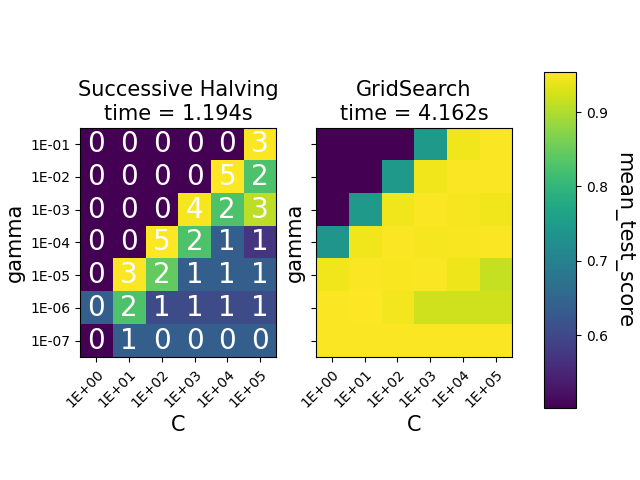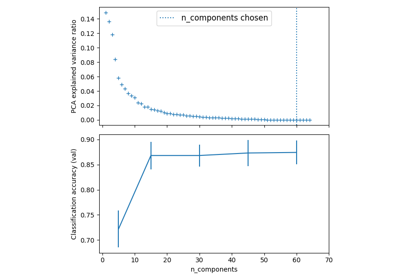备注
Go to the end 下载完整的示例代码。或者通过浏览器中的MysterLite或Binder运行此示例
网格搜索和连续减半的比较#
此示例比较了由 HalvingGridSearchCV 和 GridSearchCV .
# Authors: The scikit-learn developers
# SPDX-License-Identifier: BSD-3-Clause
from time import time
import matplotlib.pyplot as plt
import numpy as np
import pandas as pd
from sklearn import datasets
from sklearn.experimental import enable_halving_search_cv # noqa: F401
from sklearn.model_selection import GridSearchCV, HalvingGridSearchCV
from sklearn.svm import SVC
我们首先定义一个 SVC 估计器,并计算训练 HalvingGridSearchCV 例如,以及 GridSearchCV instance.
rng = np.random.RandomState(0)
X, y = datasets.make_classification(n_samples=1000, random_state=rng)
gammas = [1e-1, 1e-2, 1e-3, 1e-4, 1e-5, 1e-6, 1e-7]
Cs = [1, 10, 100, 1e3, 1e4, 1e5]
param_grid = {"gamma": gammas, "C": Cs}
clf = SVC(random_state=rng)
tic = time()
gsh = HalvingGridSearchCV(
estimator=clf, param_grid=param_grid, factor=2, random_state=rng
)
gsh.fit(X, y)
gsh_time = time() - tic
tic = time()
gs = GridSearchCV(estimator=clf, param_grid=param_grid)
gs.fit(X, y)
gs_time = time() - tic
现在我们为两个搜索估计器绘制热图。
def make_heatmap(ax, gs, is_sh=False, make_cbar=False):
"""Helper to make a heatmap."""
results = pd.DataFrame(gs.cv_results_)
results[["param_C", "param_gamma"]] = results[["param_C", "param_gamma"]].astype(
np.float64
)
if is_sh:
# SH dataframe: get mean_test_score values for the highest iter
scores_matrix = results.sort_values("iter").pivot_table(
index="param_gamma",
columns="param_C",
values="mean_test_score",
aggfunc="last",
)
else:
scores_matrix = results.pivot(
index="param_gamma", columns="param_C", values="mean_test_score"
)
im = ax.imshow(scores_matrix)
ax.set_xticks(np.arange(len(Cs)))
ax.set_xticklabels(["{:.0E}".format(x) for x in Cs])
ax.set_xlabel("C", fontsize=15)
ax.set_yticks(np.arange(len(gammas)))
ax.set_yticklabels(["{:.0E}".format(x) for x in gammas])
ax.set_ylabel("gamma", fontsize=15)
# Rotate the tick labels and set their alignment.
plt.setp(ax.get_xticklabels(), rotation=45, ha="right", rotation_mode="anchor")
if is_sh:
iterations = results.pivot_table(
index="param_gamma", columns="param_C", values="iter", aggfunc="max"
).values
for i in range(len(gammas)):
for j in range(len(Cs)):
ax.text(
j,
i,
iterations[i, j],
ha="center",
va="center",
color="w",
fontsize=20,
)
if make_cbar:
fig.subplots_adjust(right=0.8)
cbar_ax = fig.add_axes([0.85, 0.15, 0.05, 0.7])
fig.colorbar(im, cax=cbar_ax)
cbar_ax.set_ylabel("mean_test_score", rotation=-90, va="bottom", fontsize=15)
fig, axes = plt.subplots(ncols=2, sharey=True)
ax1, ax2 = axes
make_heatmap(ax1, gsh, is_sh=True)
make_heatmap(ax2, gs, make_cbar=True)
ax1.set_title("Successive Halving\ntime = {:.3f}s".format(gsh_time), fontsize=15)
ax2.set_title("GridSearch\ntime = {:.3f}s".format(gs_time), fontsize=15)
plt.show()

热图显示参数组合的平均测试分数 SVC instance.的 HalvingGridSearchCV 还显示了上次使用组合的迭代。标记为 0 仅在第一次迭代时评估,而具有 5 是被认为是最好的参数组合。
我们可以看到 HalvingGridSearchCV 类能够找到与 GridSearchCV ,在更短的时间内。
Total running time of the script: (0分5.473秒)
相关实例
Gallery generated by Sphinx-Gallery <https://sphinx-gallery.github.io> _




